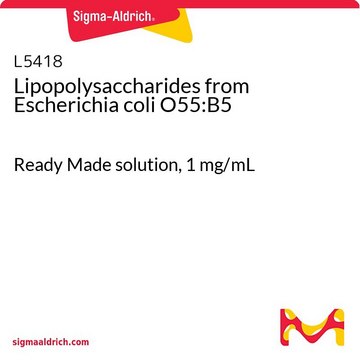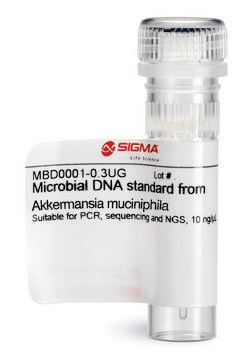SBR00027
Lipopolysaccharides from Akkermansia muciniphila
Purified by phenol extraction
About This Item
Polecane produkty
pochodzenie biologiczne
(Akkermansia muciniphila)
Poziom jakości
Formularz
lyophilized powder
kolor
white to faint yellow
rozpuszczalność
water: 1 mg/mL, faintly hazy to hazy, colorless to light yellow
temp. przechowywania
2-8°C
Opis ogólny
Zastosowanie
- w celu upośledzenia funkcji barierowych połączenia ścisłego monowarstw komórek Caco-2
- hodowane razem z A. muciniphila w celu zbadania ich wpływu na ekspresję domeny pirynowej NLR zawierającej 3 (NLRP3) w komórkach Raw264.7
- aktywacja komórek HepG2 jako endotoksyny wraz z kwasem palmitynowym (PA)
Działania biochem./fizjol.
A. muciniphila degraduje śluz i wykorzystuje go jako źródło węgla/azotu. W rezultacie gospodarz wytwarza dodatkowy śluz, podczas gdy bakteria wytwarza oligosacharydy i krótkołańcuchowe kwasy tłuszczowe (SCFA), które mogą być wykorzystywane przez gospodarza i wyzwalać układ odpornościowy. Dodatkowym efektem ochronnym SCFA jest stymulacja wzrostu mikrobioty związanej ze śluzem, która służy jako bariera przed przenikaniem patogenów do komórek jelitowych.,
A. muciniphila został uznany za korzystny mikroorganizm nowej generacji. Kilka doniesień wskazuje, że A. muciniphila wpływa na metabolizm glukozy, metabolizm lipidów i odporność jelit. Ponadto, obniżony poziom A. muciniphila jest związany z rozwojem niektórych chorób, takich jak zaburzenia metaboliczne i choroby zapalne (otyłość, cukrzyca typu 2, nieswoiste zapalenie jelit (IBD), autyzm i atopia). Weir i wsp. stwierdzili korelację między niskim poziomem A. muciniphila a rakiem jelita grubego. Shigemetzu Y i wsp. stwierdzili, że A. muciniphila działa jako regulator odpowiedzi na blokadę PD-1, która jest stosowana w immunoterapii przeciwnowotworowej. A. muciniphila indukuje komórki dendrytyczne do wydzielania IL-12, która jest krytycznym składnikiem przeciwnowotworowego działania blokady PD-1.
LPS z A. muciniphila stymulują zależną od NF-κB produkcję wydzielanej fosfatazy alkalicznej komórek embrionalnych (SEAP) poprzez TLR4. Ponadto indukują IL-8, IL-6 i minimalne ilości IL-10 i TNF-α w komórkach jednojądrzastych krwi obwodowej (PBMC). Stwierdzono, że stymulacja produkcji IL-8 przez enterocyty przez A. muciniphila jest znacznie (100-krotnie) niższa niż stymulacja przez E. coli. Niska aktywność prozapalna utrzymuje układ odpornościowy związany z błoną śluzową na odpowiednim poziomie w celu wytworzenia homeostazy błony śluzowej.
Inne uwagi
Hasło ostrzegawcze
Danger
Zwroty wskazujące rodzaj zagrożenia
Zwroty wskazujące środki ostrożności
Klasyfikacja zagrożeń
Acute Tox. 2 Oral
Kod klasy składowania
6.1A - Combustible acute toxic Cat. 1 and 2 / very toxic hazardous materials
Klasa zagrożenia wodnego (WGK)
WGK 3
Temperatura zapłonu (°F)
Not applicable
Temperatura zapłonu (°C)
Not applicable
Wybierz jedną z najnowszych wersji:
Certyfikaty analizy (CoA)
It looks like we've run into a problem, but you can still download Certificates of Analysis from our Dokumenty section.
Proszę o kontakt, jeśli potrzebna jest pomoc Obsługa Klienta
Masz już ten produkt?
Dokumenty związane z niedawno zakupionymi produktami zostały zamieszczone w Bibliotece dokumentów.
Produkty
Poznaj strukturę, funkcję i różnorodne zastosowania lipopolisacharydów. Odkryj ich rolę w bakteriach, specyficzność serologiczną i potencjał badawczy.
Nasz zespół naukowców ma doświadczenie we wszystkich obszarach badań, w tym w naukach przyrodniczych, materiałoznawstwie, syntezie chemicznej, chromatografii, analityce i wielu innych dziedzinach.
Skontaktuj się z zespołem ds. pomocy technicznej





